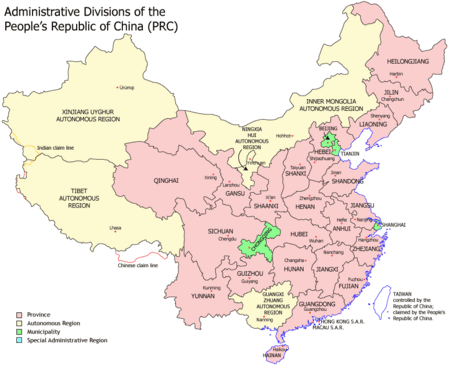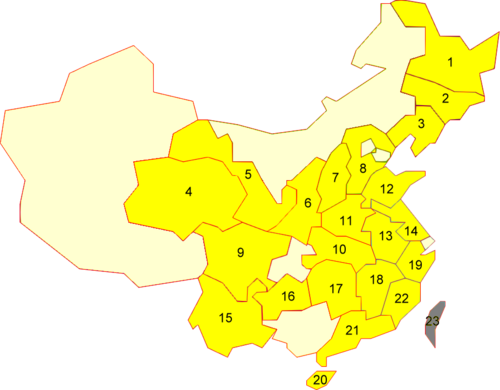Province (China)
| Administrative divisions of the People's Republic of China |
| Province level |
|---|
| Provinces |
| Autonomous regions |
| Municipalities |
| Special Administrative Regions (SARs) |
| Prefecture level |
| Prefectures Autonomous prefectures |
| Prefecture-level cities Sub-provincial cities |
| Leagues |
| County level |
| Counties Autonomous counties |
| County-level cities Sub-prefecture-level cities |
| City districts |
| Banners Autonomous banners |
| Township level |
| Townships (ethnic) Sumu (ethnic) |
| Towns |
| Subdistricts |
| County districts (defunct) |
A province, in the context of China, is a translation of sheng (Chinese: 省; pinyin: shěng), which is an administrative division. Together with municipalities, autonomous regions, and the special administrative regions, provinces make up the first level (known as the province level) of administrative division in China.[1] Provinces are also the first level division of the Republic of China, commonly called "Taiwan", though this role has been diminished.
The People's Republic of China (PRC) currently controls 22 provinces. The PRC also claims, but does not control, Taiwan as a 23rd province. The Republic of China (ROC) controls Taiwan, as well as some offshore islands including Kinmen and Matsu, very near to Fujian province.
In the People's Republic of China, every province has a Communist Party of China provincial committee, headed by a secretary. The committee secretary is first-in-charge of the province, rather than the governor of the provincial government.
Contents |
Facts about the provinces
- Until the Republic of China administration, Hebei was known as "Zhili", or "directly-ruled".
- Guangxi was made an autonomous region under the PRC government in 1958. Before then, it was a province like any other.
- The largest province by area is Qinghai, which also has the smallest population of just over 5.3 million, although Xinjiang and Tibetan "autonomous regions", effectively provinces, are larger.
- Eight of the provinces of the People's Republic of China have a sea coast. The remaining 14 are land-locked.
- Guangdong, Shandong and Liaoning all have a major peninsula.
- Guangdong is the only province bordering the only two Special Administrative Regions of China.
- Separated from Guangdong and established in 1988, Hainan is the youngest province of China.
- The Municipality of Chongqing was carved out of Sichuan province on June 12, 1997.
Map and list

For a larger version of this map, see .
Administrative divisions of the People's Republic of China. Note: this map depicts the theoretical administrative divisions of the People's Republic of China, which are not synchronized with the actual administrative divisions of the Republic of China. The People's Republic of China (PRC) controls mainland China, Hong Kong, and Macao while the Republic of China controls Taiwan and nearby islands.
 |
| Map # | Name | Chinese (T) | Chinese (S) | Pinyin | Postal map | Abb.¹ | Area² | Capital | Region | ISO | Admin. Division |
|---|---|---|---|---|---|---|---|---|---|---|---|
| 1 | Heilongjiang | 黑龍江 | 黑龙江 | Hēilóngjiāng | Heilungkiang | 黑 hēi | 454,000 | Harbin | Northeast | CN-23 | List |
| 2 | Jilin | 吉林 | 吉林 | Jílín | Kirin | 吉 jí | 187,400 | Changchun | Northeast | CN-22 | List |
| 3 | Liaoning | 遼寧 | 辽宁 | Liáoníng | Fengtien | 辽 liáo | 145,900 | Shenyang | Northeast | CN-21 | List |
| 4 | Qinghai | 青海 | 青海 | Qīnghǎi | Tsinghai | 青 qīng | 721,200 | Xining | Northwest | CN-63 | List |
| 6 | Shaanxi | 陝西 | 陕西 | Shǎnxī | Shensi | 陕 shǎn or 秦 qín | 205,600 | Xi'an | Northwest | CN-61 | List |
| 5 | Gansu | 甘肅 | 甘肃 | Gānsù | Kansu | 甘 gān or 陇 lǒng | 454,300 | Lanzhou | Northwest | CN-62 | List |
| 7 | Shanxi | 山西 | 山西 | Shānxī | Shansi | 晋 jìn | 156,300 | Taiyuan | North | CN-14 | List |
| 8 | Hebei | 河北 | 河北 | Héběi | Hopeh | 冀 jì | 187,700 | Shijiazhuang | North | CN-13 | List |
| 9 | Sichuan | 四川 | 四川 | Sìchuān | Szechuan | 川 chuān or 蜀 shǔ | 485,000 | Chengdu | Southwest | CN-51 | List |
| 10 | Hubei | 湖北 | 湖北 | Húběi | Hupeh | 鄂 è | 185,900 | Wuhan | South Central | CN-42 | List |
| 11 | Henan | 河南 | 河南 | Hénán | Honan | 豫 yù | 167,000 | Zhengzhou | South Central | CN-41 | List |
| 12 | Shandong | 山東 | 山东 | Shāndōng | Shantung | 鲁 lǔ | 153,800 | Jinan | East | CN-37 | List |
| 13 | Anhui | 安徽 | 安徽 | Ānhuī | Anhwei | 皖 wǎn | 139,700 | Hefei | East | CN-34 | List |
| 14 | Jiangxi | 江西 | 江西 | Jiāngxī | Kiangsi | 赣 gàn | 167,000 | Nanchang | East | CN-36 | List |
| 15 | Yunnan | 雲南 | 云南 | Yúnnán | Yunnan | 滇 diān or 云 yún | 394,000 | Kunming | Southwest | CN-53 | List |
| 16 | Guizhou | 貴州 | 贵州 | Gùizhōu | Kweichow | 黔 qián or 贵 gùi | 176,000 | Guiyang | Southwest | CN-52 | List |
| 17 | Hunan | 湖南 | 湖南 | Húnán | Hunan | 湘 xiāng | 210,000 | Changsha | South Central | CN-43 | List |
| 18 | Jiangsu | 江蘇 | 江苏 | Jiāngsū | Kiangsu | 苏 sū | 102,600 | Nanjing | East | CN-32 | List |
| 19 | Zhejiang | 浙江 | 浙江 | Zhèjiāng | Chekiang | 浙 zhè | 102,000 | Hangzhou | East | CN-33 | List |
| 20 | Hainan | 海南 | 海南 | Hǎinán | Hainan | 琼 qióng | 34,000 | Haikou | South Central | CN-46 | List |
| 21 | Guangdong | 廣東 | 广东 | Guǎngdōng | Kwangtung | 粤 yuè | 180,000 | Guangzhou | South Central | CN-44 | List |
| 22 | Fujian | 福建 | 福建 | Fújiàn | Fukien | 闽 mǐn | 121,300 | Fuzhou | East | CN-35 | List |
| 23 | Taiwan † | 臺灣 | 台湾 | Táiwān | Taiwan | 台 tái | 35,581 | Taibei | East | CN-71 | List |
Notes:
- ¹: Abbreviation for each Province level region
- ²: in km²
- †: Since its founding in 1949, the People's Republic of China has considered Taiwan Province to be its 23rd province even though it has never controlled any part of Taiwan. The Republic of China currently controls this area, which consists of Taiwan island and the Pescadores. The ROC also controls one county of Fuchien (or Fukien) province: Kinmen; and part of a second county: Lienchiang.
History
- See also: History of the political divisions of China
|
This article is part of
Administrative divisionsa series on the of the Republic of China |
| In effect |
|---|
| Provinces (streamlined) |
| Municipalities |
| Counties Provincial cities |
| County-controlled cities Districts Urban townships Rural townships |
| Urban villages Rural villages |
| Neighborhoods |
| Suspended |
| Regions (also known as "Areas") |
| Special administrative regions (SARs) |
| Leagues Special banners |
| Bureaus Management bureaus Banners |
| Compare Administrative levels and divisions of the People's Republic of China |

The provinces of China were first set up during the Yuan Dynasty. There were initially 10 provinces. By the time the Qing Dynasty was established, there were 18, all of which were in China proper. These were:
For every province, there was a xunfu (巡撫), a political overseer on behalf of the emperor, and a tidu (提督), a military governor. In addition, there was a zongdu (總督), a general military inspector or governor general, for every two to three provinces.
Outer regions of China (those beyond China proper) were not divided into provinces. Manchuria (consisting of Fengtian (now Liaoning), Jilin, Heilongjiang), Xinjiang, and Mongolia were overseen by military leaders or generals (將軍) and vice-dutong (副都統), and civilian leaders were heads of the leagues (盟長), a subdivision of Mongolia. Tibet was administratively overseen by the ambans (驻藏大臣).
In 1878, Xinjiang became a province, in 1909, Fengtian, Jilin, and Heilongjiang were made provinces as well. Taiwan was made a province in 1887, but it was ceded to Japan in 1895. As a result, there were 22 provinces in China (Outer China and China proper) near the end of the Qing Dynasty.
The Republic of China, established in 1912, set up 4 more provinces in Inner Mongolia and 2 provinces in historic Tibet, bringing the total to 28. 4 provinces were however lost with the establishment of the Japanese puppet state of Manchukuo in Manchuria. After the defeat of Japan in World War II, Manchuria was reincorporated as 10 provinces, and control of Taiwan was assumed by the Republic of China. As a result, the Republic of China had 35 provinces. Although the Republic of China now only controls one province (Taiwan) and some islands of a second province (Fujian), it continues to formally claim all 35 provinces.
List of defunct provinces
| Name | Chinese (T) | Chinese (S) | Pinyin | Postal map | Area¹ | Capital | Region |
Present Annexation |
|---|---|---|---|---|---|---|---|---|
| Andong | 安東 | 安东 | Āndōng | Antung | 62,279 | Tonghua | Northeast | Liaoning, Jilin |
| Chahar | 察哈爾 | 察哈尔 | Cháhār | Chahar | 278,957 | Zhangjiakou | Northeast | Inner Mongolia, Hebei |
| Hejiang | 合江 | 合江 | Héjiāng | Hokiang | 135,406 | Jiamusi | Northeast | Heilongjiang |
| Liaobei | 遼北 | 辽北 | Liáoběi | Liaopeh | 121,624 | Liaoyuan | Northeast | Liaoning, Jilin, Inner Mongolia |
| Nenjiang | 嫩江 | 嫩江 | Nènjiāng | Nunkiang | 67,034 | Qiqihar | Northeast | Heilongjiang |
| Rehe | 熱河 | 热河 | Rèhé | Jehol | 179,982 | Chengde | Northeast | Hebei, Liaoning, Inner Mongolia |
| Songjiang | 松江 | 松江 | Sōngjiāng | Sungkiang | 84,559 | Mudanjiang | Northeast | Heilongjiang |
| Suiyuan | 綏遠 | 绥远 | Suíyuǎn | Suiyuan | 329,397 | Guisui (Hohhot) | Northeast | Inner Mongolia |
| Xikang | 西康 | 西康 | Xīkān | Sikang | 451,521 | Kangding | Southwest | Tibet, Sichuan |
| Xing'an | 興安 | 兴安 | Xīng'ān | Hsingan | 278,437 | Hailar | Northeast | Inner Mongolia |
Notes:
- ¹: in km²
The People's Republic of China abolished many of the provinces in the 1950s and converted a number of them into autonomous regions. Hainan was set up as a separate province in 1988, bringing the total number of provinces under its control to 22.
References
- ↑ Administrative divisions of China
- ↑ References and details on data provided in the table can be found within the individual provincial articles.
External links
See also
- Zhou (country subdivision)
- Chinese federalism
- Taiwan Province
- Tiao-kuai
- List of China administrative divisions by population
- List of China provinces by compass
|
||||||||
|
||||||||||||||||||||||||||||||||||||||||||||||||||||||||||||||||||||||||||||||